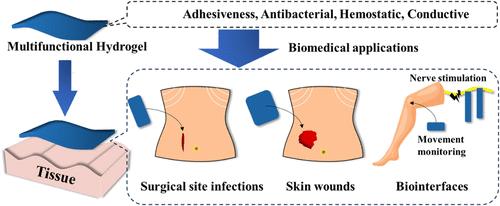Hydrogel Adhesive with Tunable Multifunctionality by the Addition of Weak Bonds Based on Polydopamine for Versatile Wound Healing Applications and Biointerfaces
IF 8.2
2区 材料科学
Q1 MATERIALS SCIENCE, MULTIDISCIPLINARY
引用次数: 0
Abstract
Developing high-performance adhesives that integrate both strength and flexibility is essential for versatile medical applications; however, achieving both properties simultaneously in a single material remains a challenge. In this study, we introduce polydopamine (PDA) into hydrogel networks to form sacrificial bonds, which consist of multiple types of noncovalent, energy-dissipating interactions under stress, allowing the material to stretch and recover without breaking. This mechanism not only enables synergistic interactions that enhance both strength and extensibility but also allows for rapid and robust adhesion to various tissue interfaces, effectively sealing defects and stopping bleeding in models of tail, liver, and heart injuries. Additionally, the hydrogels demonstrate excellent antibacterial properties, biocompatibility, and in situ macrophage modulation. In both rat and pig injury models, the hydrogel adhesives efficiently close wounds and accelerate healing. These findings underscore the significant potential of these sacrificially bonded hydrogels for surgical applications, including hemostatic sealing, infection prevention, and sutureless wound closure. Additionally, they could also serve as bioelectronics interfacing materials, enabling the recording and stimulation of physiological activities.

通过添加基于聚多巴胺的弱键,具有可调多功能的水凝胶粘合剂,用于多用途伤口愈合应用和生物界面
开发兼具强度和柔韧性的高性能粘合剂对于多功能医疗应用至关重要;然而,在一种材料中同时实现这两种特性仍然是一个挑战。在这项研究中,我们将聚多巴胺(PDA)引入到水凝胶网络中形成牺牲键,这种牺牲键由多种类型的非共价、能量耗散的相互作用组成,使材料能够在不断裂的情况下拉伸和恢复。这种机制不仅能够增强协同作用的强度和可扩展性,而且还允许快速和强大的粘附到各种组织界面,有效地密封缺陷,并在尾巴,肝脏和心脏损伤模型中止血。此外,水凝胶表现出优异的抗菌性能,生物相容性和巨噬细胞原位调节。在大鼠和猪的损伤模型中,水凝胶粘接剂都能有效地闭合伤口并加速愈合。这些发现强调了这些牺牲粘合水凝胶在外科应用方面的巨大潜力,包括止血密封、感染预防和无缝线伤口缝合。此外,它们还可以作为生物电子界面材料,实现生理活动的记录和刺激。
本文章由计算机程序翻译,如有差异,请以英文原文为准。
求助全文
约1分钟内获得全文
求助全文
来源期刊

ACS Applied Materials & Interfaces
工程技术-材料科学:综合
CiteScore
16.00
自引率
6.30%
发文量
4978
审稿时长
1.8 months
期刊介绍:
ACS Applied Materials & Interfaces is a leading interdisciplinary journal that brings together chemists, engineers, physicists, and biologists to explore the development and utilization of newly-discovered materials and interfacial processes for specific applications. Our journal has experienced remarkable growth since its establishment in 2009, both in terms of the number of articles published and the impact of the research showcased. We are proud to foster a truly global community, with the majority of published articles originating from outside the United States, reflecting the rapid growth of applied research worldwide.
 求助内容:
求助内容: 应助结果提醒方式:
应助结果提醒方式:


